Deep History Of America’s Deep State (2)
Read the first part of the article
Showboat Patriot and bond speculator Samuel Adams – former mastermind of the Boston Tea Party and erstwhile propagandist against unfair British taxes (as well as cousin to Abigail’s husband John Adams) – sponsored a Massachusetts law that allowed sheriffs to kill tax protesters outright.
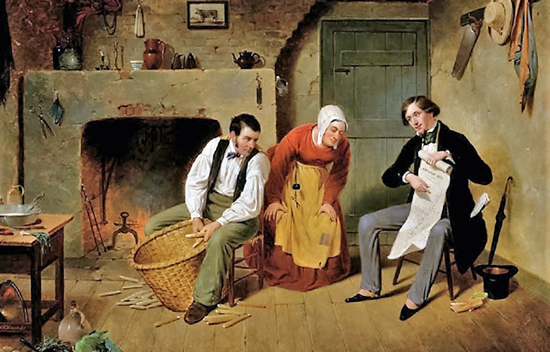
Another rich bondholder and speculator, ex-Revolutionary War General Henry Knox (the fitting namesake of Fort Knox, the famous repository of gold bullion) wrote an alarming letter to his former commander George Washington, accusing the Shays’s rebels of being “levelers” (which was the closest term to “communists” then in existence). He informed Washington that the country needed a much stronger government (and military) to prevent any riffraff challenge to the elite. His message was not wasted on General Washington, America’s richest slave owner.
In the end, the Congress, under the Articles of Confederation, could raise no money from the states to provide an army, but the privately-financed, for-profit Massachusetts militia successfully defeated Shays’s rebels. Still, the nearly hysterical fear of democratic economic revolution had been planted in the minds of the masters. Shays’s Rebellion proved to be the last straw for bond speculators whose profits were jeopardized by democracy.
Worse even, the governments of many other states were beginning to cave under intense democratic pressure from rebellious debtors. Some states were entertaining laws that prevented the seizure of property for debt; others were creating paper money in order to break the gold and silver monopoly. Rhode Island not only voted in a paper money system, but threatened to socialize all commercial business enterprises in the state.
In response to the threat of populism, the “virtuous” elite reacted decisively – not to remedy the plight of debtors, of course – but to secure their own profits from them. Accordingly, in 1786, five states sent delegates to meet at Annapolis, Maryland, just as Shays’s Rebellion veered into revolution. This unelected minority called for Congress to authorize a convention to be held in Philadelphia the next year “for the sole and express purpose of revising the Articles of Confederation.” The Articles were never to be “revised”. They were to be scrapped altogether by the Deep State.
The Deep State Conspires
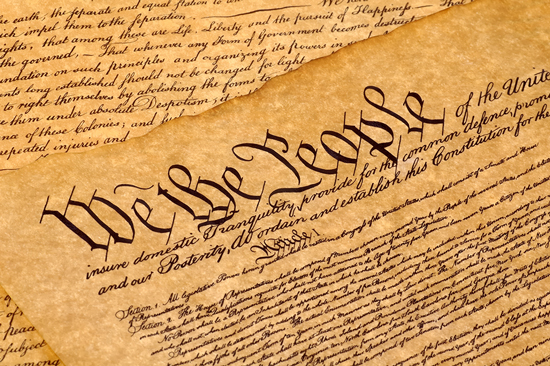
Thanks to Charles A. Beard’s An Economic Interpretation of the Constitution of the United States, we know quite a lot about the status of the 55 men who conspired to draft the US Constitution. But the very first thing we need to know is that they were not authorized by “We the People” simply because nobody had voted for them; all were political appointees. Nor were they even a representative sample of the people. Not a single person in the Convention hall worked for a living, nor was female, nor was a person of color. Only one claimed to be a farmer, the current occupation of about 90 percent of the population. Most were lawyers. Go figure.
If the delegates represented anybody at all, it was the economic elite: 80 percent were bondholders; 44 percent were money-lenders; 27 percent were slave owners; and 25 percent were real estate speculators.
Demographically, the 39 who finally signed the final draft of the US Constitution constituted 0.001 percent of the American population reported in the 1790 census. George Washington, who presided, was arguably the wealthiest man in the country. They were all Deep State gamblers. And the stakes were high. Recall that the face value of outstanding domestic government bonds in 1787 was $60 million, equivalent to 10 percent of the total improved land value of the country. But these bonds, for the most part, had been obtained by speculators at a fraction of face value.
Beard very conservatively estimated the profit of speculators – if the bond were redeemed at face value – would have been some $40 million. Expressed as the same proportion of total improved land value at the time of the Founding, the expected profit from government bonds held then would equal at least $3 trillion today. Tax free.
We still do not know everything that transpired at the convention. No one was assigned to keep a record of what was discussed. Reportedly, even the windows to the meeting hall were nailed shut to prevent eavesdropping – though there would be “leaks”. Because of its secrecy and its unauthorized nature, some historians have called the convention “the second American Revolution”. But revolutions are public, hugely participatory events. This was a coup d’état behind locked doors.
Most delegates presumably understood their undisclosed purpose was to dump the whole system of confederated government (which had cost 25,000 American lives to secure) into a dustbin. They evidently did not intend to obey their instructions “solely to revise” the Articles because a number of them showed up at the convention with drafts for a new constitution in hand.
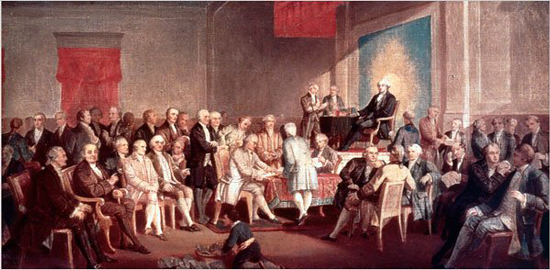
The conspirators’ ultimate goal was to replace the Confederation with what they later euphemized as “a more perfect Union” – designed from the outset to protect their class interests and to ensure the new government possessed all the power necessary to perpetuate the existing oligarchy.
At the Convention, Alexander Hamilton captured the prevailing sentiment: “All communities divide themselves into the few and the many. The first are the rich and well-born; the other the mass of the people… turbulent and changing, they seldom judge or determine right.
Give therefore to the first class a distinct, permanent share in the Government… Nothing but a permanent body can check the imprudence of democracy.”
Hamilton further proposed that both the President and the Senate be appointed (not elected) for life. His vision was but half a step removed from monarchy. Though not a Convention delegate, John Jay, Hamilton’s political ally, slave-owner, and the first Chief Justice of the Supreme Court, stated the purpose of “republicanism” with brutal brevity: “The people who own the country ought to govern it.”
The Founders never once envisioned any such a thing as “limited government” – unless perhaps in the sense that the power of government was to be limited to their own economic class. In Towards an American Revolution: Exposing the Constitution & Other Illusions, historian Jerry Fresia sums the Founders’ views succinctly: “The vision of the Framers, even for Franklin and Jefferson who were less fearful of the politics of the common people than most, was that of a strong centralized state, a nation whose commerce and trade stretched around the world. In a word, the vision was one of empire where property owners would govern themselves.”
Self-government by the people was to remain permanently out of the question. The Deep State was to govern itself. “We the People”, a phrase hypocritically coined by the ultra-aristocrat Governor Morris, would stand forever after as an Orwellian hoax.
The tricky task of the hand-picked delegates was to hammer out a radical new system of government that would superficially resemble a democratic republic, but function as an oligarchy.
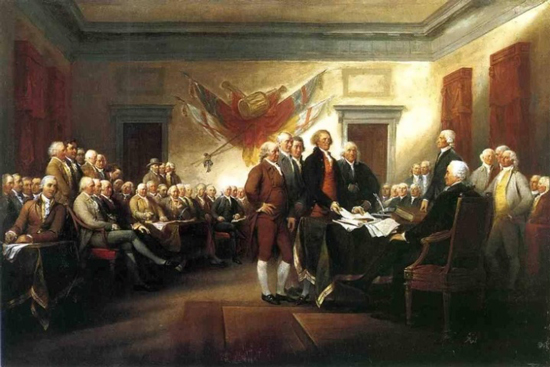
William Hogeland’s excellent Founding Finance, recounts the anti-democratic vehemence expressed at the Convention: “On the first day of the meeting that would become known as the United States Constitutional Convention, Edmund Randolph of Virginia kicked off the proceedings. […] ‘Our chief danger’, Randolph announced, ‘arises from the democratic parts of our constitutions. … None of the constitutions’ – he meant those of the states’ governments – ‘have provided sufficient checks against the democracy’.”
No wonder they nailed the windows shut. It should be no surprise that the word “democracy” does not appear once in the entire U.S. Constitution, or any of its Amendments, including the Bill of Rights. Accordingly, the Constitution does not once refer to the popular vote, and it did not guarantee a single person or group suffrage until the adoption of the 15th Amendment in 1870, over 80 years after ratification. The Preamble aside, the Founders used the phrase “the People” only a single time (Art. I, Sec. 2).
It has been suggested the word “democracy” had a different meaning then than it has now. It did not. “Democracy” to the Convention delegates meant the same thing as it does today: “rule by the people”. That’s why they detested it. The delegates considered themselves the patriarchs of “republicanism”, the ideology that rejected participation in government by people like their wives, servants, tenants, slaves, and other non-propertied inferiors. No doubt, the delegates passionately disagreed on many things, but the “fear and loathing” of democracy was not one of them. Then or now.
The Deep State’s Specific Goals
Embedded within the Founders’ broadly anti-democratic agenda were four specific goals. These were not a list of items jotted down in advance, but were derived by group consensus as the minimum requirements necessary to achieve the Deep State’s ultimate agenda.
To camouflage the stark oligarchic nationalism the measures intended, the Founders disingenuously styled themselves “Federalists”. But nothing about these measures concerned a “federation” of sovereign states; taken together, they were intended to demolish the existing “perpetual” confederation, not to re-create it more effectively.
National government with limited citizen participation. Of all the measures required to achieve a national oligarchy, this was the most daunting. It was achieved by a wide array of provisions.
– The Electoral College. The President and Vice President are not elected by popular vote, but by electors – then and now. For example, when George Washington was first elected President, the American population was 3.9 million. How many of those folks voted for George? Exactly 69 persons – which was the total number of electors voting at the time. (Art. I, Sec. 3)
– Bi-Cameral Congress. Congress is bi-cameral, composed of two “houses” – the House of Representatives and the Senate. Under the original Constitution, the House members represented the people who vote for them, while the Senate represented states, not persons, and was therefore not a democratic body, at all. It was generally expected that the Senate would “check” the democratic House. Indeed, this was the entire purpose of bi-cameralism wherever it has existed. (Art. I, Secs. 1 and 2)
– State Appointment of Senators. Senators were originally appointed by state legislatures (until the 17th Amendment in 1913). It was expected that the Senate would function in Congress as the House of Lords functioned in Parliament: the voice of the aristocracy. Even though Senators are now popularly elected, it is far more difficult to challenge an incumbent because of the prohibitive expense of running a state-wide campaign. (Art. I, Sec. 3)
– Appointment of the Judiciary. All federal judges are appointed for life terms by the President and confirmed by the (originally undemocratic) Senate. (Art. III, Sec. 1)
– Paucity of Representation. Most undemocratic of all was the extreme paucity of the total number of House members. The House originally was composed of only 65 members, or one member per 60,000 persons. Today, there are 435 members, each representing about 700,000 persons. Thus, current House representation of the public is 12 times less democratic than when the Constitution was written – and it was poor (at best) then.
– Compare. The day before the Constitution was ratified, the people of the 13 United States were represented by about 2,000 democratically elected representatives in their various state legislatures (1:1950 ratio); the day after ratification, the same number of people were to be represented by only 65 representatives in the national government (1:60,000).
In quantitative terms, this represents more than a 3,000 percent reduction of democratic representation for the American people. (Art. I, Sec. 2)
– Absence of Congressional Districts. Although House members now run for election in equal-populated districts, the districts were created by Congress, not the Constitution. Until the 1960s, some House members were elected at-large (like Senators). This disadvantaged all but the richest and best-known candidates from winning. (Not referenced in Constitution)
– Absence of Recall, Initiative and Referendum. The Constitution does not allow the people to vote to recall (un-elect) a Congress member, demand a Congressional vote on any issue (propose an initiative) or vote directly in a referendum on any issue (direct democracy). (Not referenced in Constitution)
– Absence of Independent Amendment Process. One of the reasons Americans now have professional politicians is that the Constitution does not provide a way for “the people” to amend it without the required cooperation of a sitting Congress. At the Constitutional convention, Edmund Randolph of Virginia (surprisingly) proposed that the people be afforded a way to amend the Constitution without the participation of Congress. This excellent idea, however, was not adopted. (Art. V)
– National authority to tax citizens directly. (Art. I, Sec. 8; 16th Amendment)
– National monopolization of military power. (Art. I, Sec.8, clauses 12, 13, 14, 15, 16)
– Denial of states’ power to issue paper money or provide debtor relief. (Art. I, Sec.10; Art. I Sec.8, clause 4)
All of these provisions were completely new in the American experience. For 150 years or more, citizen participation in government, independent militias, and the issuance of paper money had been the prerogative of the several, independent colonies/states – while direct external taxation had been universally and strenuously resisted.
When the British Crown had threatened to curtail colonial prerogatives, the very men who now conspired for national power had risen in armed rebellion. The hypocrisy was stunning. And people took note of the fact.
Consent of the Minority
One of the note-takers was Robert Yates, a New York delegate to the Convention, who had walked out in protest. Not long afterwards, Yates (who owned no government bonds) stated his objection to the new Constitution: “This government is to possess absolute and uncontrollable power, legislative, executive and judicial, with respect to every object to which it extends. The government then, so far as it extends, is a complete one. … It has the authority to make laws which will affect the lives, the liberty, and the property of every man in the United States; nor can the constitution or the laws of any state, in any way prevent or impede the full and complete execution of every power given.”
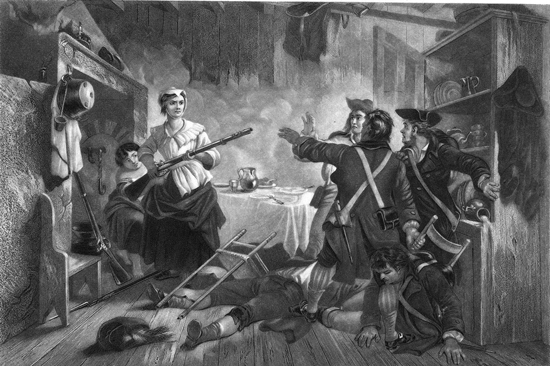
At least half of the American population (collectively called “Anti-federalists”) thought the Constitution was a terrible idea. To be sure, well-to-do Anti-federalists like Yates were not overtaxed farmers, and their objections were often based upon the defense of states’ rights, not peoples’ economic rights.
Most Anti-federalists, however, seemed alarmed that the Constitution contained no guarantee of the basic political rights they had enjoyed under the British Empire, such as freedom of speech or trial by jury.
The debate between supporters and critics of the Constitution raged for a year, while partisan newspapers published articles both pro and con. A collection of 85 “pro” articles is known now as The Federalist Papers, which were written by Alexander Hamilton, James Madison and John Jay. Although these articles have been studied almost as religious relicts by historians, they do not tell us “what the Constitution really means”.
The Constitution means what it says. The Federalist Papers are sales brochures, written by lawyers trying to get others to “buy” the Constitution. The same can be said about a similar collection of “Anti-federalist Papers” from which Yates’s quote above was taken. In any event, it is up to the courts to interpret the Constitution, not lawyers with vested interests.
In due course, the Anti-federalists put their collective foot down. There would be no hope of ratification without amendments guaranteeing fundamental political – but not economic – rights.
Although Hamilton argued a guarantee of rights would be “dangerous”, James Madison convinced the Federalists that agreeing to guarantee a future Bill of Rights would be much safer that meddling with the text of the current document, which might entail unraveling its core nationalist, anti-democratic agenda. And so, a deal was struck.
Even so, the battle over the ratification of the Constitution was not ultimately decided by the people of the nation. Although the people of the several states had not voted to authorize the Convention, or the document it had produced, the Founders had been incredibly arrogant, not to mention sly. Not only had they presented the unauthorized document to the states as a take-it-or-leave-it proposition (no changes allowed), but the document itself demanded that only special state “conventions” could ratify it – not the majority popular vote of the people.
Specifying ratification by conventions meant the people would be voting for convention delegates, who would in turn vote for ratification. This was tantamount to turning ratification into a popularity contest between convention delegates, rather than a democratically direct vote on the document, itself.
Moreover, ratification by convention would present the possibility that a minority of the people in a state (those in favor of the Constitution) might “pack” a convention with delegates, who would then approve of a document establishing a government for all.
Electoral shenanigans were not just hypothetical possibilities. In Philadelphia, for example, a mob kidnapped elected legislators who were boycotting a convention vote, physically dragged them into the state house, and tied them to their chairs in order to force a convention vote. Other, more subtle methods of manipulation occurred elsewhere, notably the disenfranchisement of voters through property qualifications.
The Deep State Hiding in Plain Sight
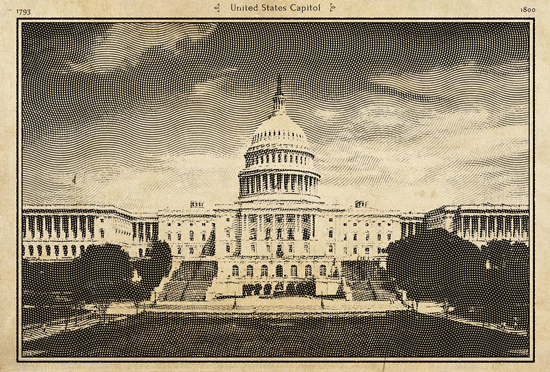
Mike Lofgren, a congressional staff member for 28 years, joins Bill Moyers to talk about what he calls “Washington’s Deep State”, in which elected and unelected figures collude to protect and serve powerful vested interests. “It is how we had deregulation, financialization of the economy, the Wall Street bust, the erosion or our civil liberties and perpetual war”, Lofgren tells Moyers.
Over a hundred years ago, Charles A. Beard completed his exhaustive study of the Constitution and confirmed that it most likely was ratified by a majority – of a minority of the people. Among Beard’s final conclusions were these: “The Constitution was ratified by a vote of probably not more than one-sixth of the adult males. The leaders who supported the Constitution in the ratifying conventions represented the same economic groups as the members of the Philadelphia Convention.
The Constitution was not created by ‘the whole people’ as the jurists [judges] have said; neither was it created by ‘the states’ as Southern nullifiers long contended; but it was the work of a consolidated group whose interests knew no state boundaries and were truly national in their scope.”
The Deep State, in other words. It was darkly appropriate that a document whose primary purpose was to defeat democratic rule was, itself, brought into force without a majoritarian vote.
In 1788, nine of the 13 states’ conventions ratified the Constitution (as specified in the Constitution’s own Article VII) and the document became the supreme law of the land for those nine states.
By 1789, even the democratic holdout Rhode Island had followed suit. And America’s schoolchildren have been led to believe ever since that the Constitution is a sacred document, inspired and ordained by the public-spirited benevolence of Founding Fathers.
But this had been predicted. It had seemed painfully obvious to Eighteenth Century Genevan political philosopher Jean-Jacques Rousseau that constitutional government was the invention of the Deep State, its designated beneficiary.
Dripping with sarcasm, his virtuoso Discourse on Inequality explained the process: “The rich man… at last conceived the deepest project that ever entered the human mind: this was to employ in his favor the very forces that attacked him, to make allies of his enemies…
In a word, instead of turning our forces against ourselves, let us collect them into a sovereign power, which may govern us by wise laws, may protect and defend all the members of the association, repel common enemies, and maintain a perpetual concord and harmony among us.”
Rousseau penned these words in 1754, 33 years before Governor Morris oversaw the drafting of the identical sales pitch that constitutes the Preamble to the United States Constitution: “We the People of the United States, in Order to form a more perfect Union, establish Justice, insure domestic Tranquility, provide for the common Defense, promote the general Welfare, and secure the Blessings of Liberty to ourselves and our Posterity, do ordain and establish this Constitution for the United States of America.”
Rousseau concludes: “All offered their necks to the yoke in hopes of securing their liberty; for though they had sense enough to perceive the advantages of a political constitution, they had not experience enough to see beforehand the dangers of it; those among them, who were best qualified to foresee abuses, were precisely those who expected to benefit by them….”
Does the Deep State pose an existential threat to American democracy today? Move along, folks – nothing new to see here.
yogaesoteric
February 2, 2018
